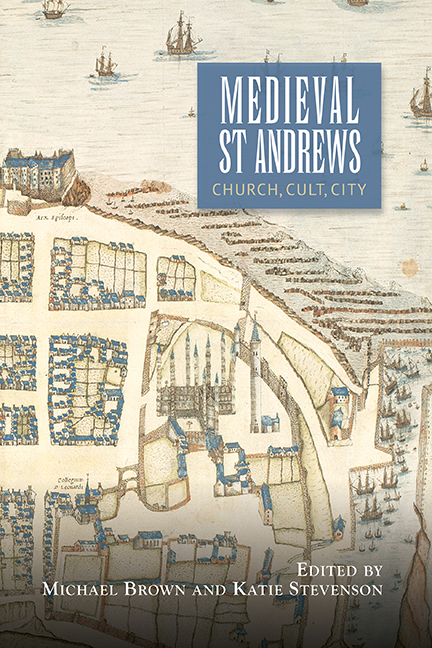Book contents
- Frontmatter
- Dedication
- Contents
- List of Illustrations, Charts and Tables
- Contributors
- Abbreviations
- 1 ‘Ancient Magnificence’: St Andrews in the Middle Ages: An Introduction
- 2 From Cinrigh Monai to Civitas Sancti Andree: A Star is Born
- 3 The Idea of St Andrews as the Second Rome Made Manifest
- 4 The Medieval Ecclesiastical Architecture of St Andrews as a Channel for the Introduction of New Ideas
- 5 When the Miracles Ceased: Shrine and Cult Management at St Andrews and Scottish Cathedrals in the Later Middle Ages
- 6 Religion, Ritual and the Rhythm of the Year in Later Medieval St Andrews
- 7 Living in the Late Medieval Town of St Andrews
- 8 The Burgh of St Andrews and its Inhabitants before the Wars of Independence
- 9 The Archaeology of Medieval St Andrews
- 10 Prelates, Citizens and Landed Folk: St Andrews as a Centre of Lordship in the Late Middle Ages
- 11 Augmenting Rentals: The Expansion of Church Property in St Andrews, c. 1400–1560
- 12 The Prehistory of the University of St Andrews
- 13 University, City and Society
- 14 The Medieval Maces of the University of St Andrews
- 15 Heresy, Inquisition and Late Medieval St Andrews
- Appendix 1 The St Andrews Foundation Account
- Appendix 2 The Augustinian' Account
- Appendix 3 The Boar' Raik
- Appendix 4 University of St Andrews Library, UYSL 110/6/4
- Index
- Miscellaneous Endmatter
4 - The Medieval Ecclesiastical Architecture of St Andrews as a Channel for the Introduction of New Ideas
Published online by Cambridge University Press: 28 April 2017
- Frontmatter
- Dedication
- Contents
- List of Illustrations, Charts and Tables
- Contributors
- Abbreviations
- 1 ‘Ancient Magnificence’: St Andrews in the Middle Ages: An Introduction
- 2 From Cinrigh Monai to Civitas Sancti Andree: A Star is Born
- 3 The Idea of St Andrews as the Second Rome Made Manifest
- 4 The Medieval Ecclesiastical Architecture of St Andrews as a Channel for the Introduction of New Ideas
- 5 When the Miracles Ceased: Shrine and Cult Management at St Andrews and Scottish Cathedrals in the Later Middle Ages
- 6 Religion, Ritual and the Rhythm of the Year in Later Medieval St Andrews
- 7 Living in the Late Medieval Town of St Andrews
- 8 The Burgh of St Andrews and its Inhabitants before the Wars of Independence
- 9 The Archaeology of Medieval St Andrews
- 10 Prelates, Citizens and Landed Folk: St Andrews as a Centre of Lordship in the Late Middle Ages
- 11 Augmenting Rentals: The Expansion of Church Property in St Andrews, c. 1400–1560
- 12 The Prehistory of the University of St Andrews
- 13 University, City and Society
- 14 The Medieval Maces of the University of St Andrews
- 15 Heresy, Inquisition and Late Medieval St Andrews
- Appendix 1 The St Andrews Foundation Account
- Appendix 2 The Augustinian' Account
- Appendix 3 The Boar' Raik
- Appendix 4 University of St Andrews Library, UYSL 110/6/4
- Index
- Miscellaneous Endmatter
Summary
ST Andrews has – and almost certainly always has had – the greatest number of pre-Reformation ecclesiastical buildings of any Scottish burgh. Many of those buildings can be seen to have striven after strikingly innovative approaches to architectural design as a way of making a carefully calculated impression on the beholder. Here it must be remembered that, through its scale and the degree of artistic originality, architecture has always had the potential to be one of the most potent expressions of status, and the commissioning of magnificent and thought-provoking buildings was one of the means by which the claims of the bishops and archbishops of St Andrews to primacy over their fellow prelates were bolstered. One of the fascinations of these buildings lies in trying to understand the choices underlying the complex sources of inspiration for their design.
‘St Rule's’ Church
THE oldest of St Andrews' churches to have survived in anything approaching an architecturally coherent form is that known as St Rule's, and as one of the first generation built to meet the needs of Scotland's revitalised church, its date of construction has been a keenly debated issue. One of the most significant events for its construction to the form we now see was the election as bishop in 1123 or 1124 of Robert, the prior of the Augustinian house of Scone, who had previously been a member of the priory of Nostell in Yorkshire. The expectation was that Robert would introduce a community of Augustinian canons to supplant the existing community of Culdees, though this was not achieved until 1140, after royal pressure had been applied, shortly before which another Robert had been brought up from Nostell as prior.
At the time of Bishop Robert's election, the boundaries of the precinct on the headland are said to have been defined by twelve stone crosses, within which were seven churches in addition to those dedicated to St Andrew and to the Holy Trinity. References to Bishop Robert enlarging a church and dedicating it to divine worship have been taken by some commentators to indicate that what we now see at St Rule's is an enlargement by Robert of one of those buildings already on the site when he came to St Andrews.
- Type
- Chapter
- Information
- Medieval St AndrewsChurch, Cult, City, pp. 51 - 83Publisher: Boydell & BrewerPrint publication year: 2017

